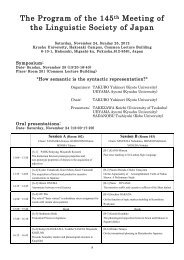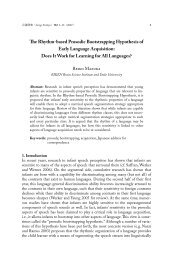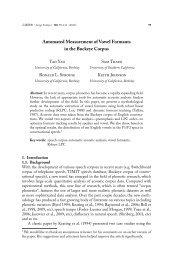第117åæ¥æ¬è§£åå¦ä¼ç·ä¼ã»å ¨å½å¦è¡éä¼ è¬æ¼ããã°ã©ã ã»æé²é PDF ...
第117åæ¥æ¬è§£åå¦ä¼ç·ä¼ã»å ¨å½å¦è¡éä¼ è¬æ¼ããã°ã©ã ã»æé²é PDF ...
第117åæ¥æ¬è§£åå¦ä¼ç·ä¼ã»å ¨å½å¦è¡éä¼ è¬æ¼ããã°ã©ã ã»æé²é PDF ...
Create successful ePaper yourself
Turn your PDF publications into a flip-book with our unique Google optimized e-Paper software.
117 149<br />
P<br />
Motor protein KIFA is essential for hippocampal synaptogenesis<br />
and learning enhancement in an enriched environment<br />
<br />
<br />
Environmental enrichment causes a variety of effects on brain structure and<br />
function. Brainderived neurotrophic factor BDNF plays an important role<br />
in enrichmentinduced neuronal changes; however, the precise mechanism<br />
underlying these effects remains uncertain. In this study, a specific upregulation of<br />
kinesin superfamily motor protein 1A KIF1A was observed in the hippocampi<br />
of mice kept in an enriched environment and, in hippocampal neurons in vitro,<br />
BDNF increased the levels of KIF1A and of KIF1Amediated cargo transport.<br />
Analysis of Bdnf +/-<br />
and Kif1a +/- mice revealed that a lack of KIF1A upregulation<br />
resulted in a loss of enrichmentinduced hippocampal synaptogenesis and learning<br />
enhancement. Meanwhile, KIF1A overexpression promoted synaptogenesis via<br />
the formation of presynaptic boutons. These findings demonstrate that KIF1A<br />
is indispensable for BDNFmediated hippocampal synaptogenesis and learning<br />
enhancement induced by enrichment. This is a new molecular motormediated<br />
presynaptic mechanism underlying experiencedependent neuroplasticity.<br />
P<br />
Activationspecific Changes of Angiotensin II Receptors in Mouse<br />
Cerebellum and Adrenal Glands with In Vivo Cryotechnique<br />
Zheng Huang, Nobuo Terada, Yurika Saitoh, Jiaorong Chen, Shinichi Ohno<br />
Department of Anatomy and Molecular Histology, Interdisciplinary Graduate<br />
School of Medicine and Engineering, University of Yamanashi<br />
We have performed immunohistochemical analyses of AT1/2R with molecular<br />
activationspecific antibodies in living mouse cerebellum and adrenal glands under<br />
normal or hypoxic conditions with “in vivo cryotechnique” IVCT followed by<br />
freezesubstitution FS. In the cerebellum, outer molecular layers and some areas<br />
around Purkinje cells were immunostained as dotted patterns, which were closely<br />
related to Bergmann glia. At 5 and 10 min after hypoxia, the immunoreactivity<br />
was remarkably reduced, though it was still remained the same in the adrenal<br />
glands at 15min after hypoxia. This immunohistochemical approach with IVCT<br />
FS enabled us to perform their precise analyses.<br />
P<br />
Nodose ganglion cells expressing melanocortin receptor send their<br />
fibers to the pancreatic islets in the mouse<br />
Toshiko Tsumori, Tatsuro Oka, Jianguo Niu, Yukihiko Yasui<br />
Dept. Anat. & Morphol. Neurosci., Shimane Univ. Sch. Med.<br />
Melanocortin system including melanocortin4 receptor MC4R plays a<br />
crucial role in the control of feeding and energy expenditure. Using a transgenic<br />
mouse model in which green fluorescent protein GFP is produced under the<br />
control of the MC4R promoter, we recently reported that the dorsal motor<br />
nucleus of the vagus nerve contains many MC4Rexpressing neurons which<br />
project to the intrapancreatic ganglia. In this study, we examined whether or<br />
not MC4Rexpressing nodose ganglion cells send their fibers to the pancreas.<br />
Using retrograde tracing with chorela toxin B subunit in combination with<br />
immunohistochemistry for GFP, we demonstrated that some of the nodose<br />
ganglion cells sending their fibers to the pancreas showed GFP immunoreactivity.<br />
Using double immunofluorecence staining for insulin and GFP, we also showed<br />
that GFPimmunoreactive ir boutonlike varicosities were distributed within<br />
the pancreatic islets and some of them were in close apposition to insulinir cell<br />
bodies. The previous and present results suggest that both of the vagal afferent<br />
and efferent neurons expressing MC4R may be closely related to exocrine and<br />
endocrine pancreatic functions on energy expenditure.<br />
P<br />
Runx<br />
<br />
<br />
Runx runt Runx13 3 <br />
Runx1 Runx1 <br />
12.5 E12.5<br />
Runx1 <br />
Runx1 Runx1 -/- ::TgE12.5 <br />
Runx1 E17.5 <br />
Runx1 Runx1 <br />
Runx1 <br />
<br />
Runx1 <br />
NeurofilamentM <br />
VAChTRunx1 +/+ ::Tg Runx1 -/- ::Tg <br />
<br />
3 <br />
Runx1 -/- ::Tg VAChT <br />
Runx1 +/+ ::Tg <br />
Runx1 -/- ::Tg Runx1 <br />
<br />
P<br />
A <br />
<br />
1 2 1<br />
1<br />
2 <br />
A Cholecystokinin A receptor: CCKAR<br />
CCK CCKAR mRNA <br />
nodose ganglion: NGNG CCK<br />
binding site <br />
CCKAR CCKAR <br />
<br />
CCK<br />
AR CCKAR <br />
2 <br />
VGluT2<br />
CCKAR <br />
CCKAR NG <br />
<br />
B <br />
NG CCKAR/<br />
VGluT2 CCKAR <br />
CCKAR <br />
NG <br />
<br />
P<br />
Features of boutons distribution along axons of neurons in the<br />
caudal nucleus of tractus solitarius of the rat<br />
<br />
<br />
A large amount of the information processing that happens in the brain occurs<br />
in the microcircuitry. For comprehensive understanding of the mechanisms<br />
regulating connectivity among neurons within the microcircuitry, it is essential<br />
to elucidate how pre and postsynaptic components are connected. In this study,<br />
to understand the rules by which axons make synapses, we investigated the<br />
arrangement of synaptic boutons on axons of biocytinfilled neurons in the caudal<br />
nucleus of the tractus solitarius cNTS of medulla oblongata. We analyzed the<br />
length and distribution of interbouton intervals ibi under the light microscope.<br />
The overall average length of ibi was 4.7 μm and varied by neurons ranged<br />
from 2.8 to 8.1 μm. Although there was considerable variation in the average<br />
length of ibi among neurons, a general scaling relationship between the standard<br />
deviation and the average was found. In addition, the distribution of ibi was<br />
characteristically skewed and the tail of that was fitted well to an exponential<br />
distribution. These results suggest that the synaptic boutons along axons of cNTS<br />
neurons are distributed in a fundamentally similar manner, a random manner.







